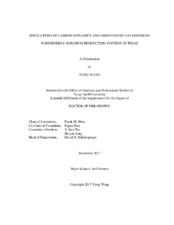| dc.description.abstract | Bioenergy sorghum [Sorghum bicolor (L.) Moench.] is a promising biofuel crop to mitigate greenhouse gas (GHG) emissions. However, optimum field management practices for its production in different regions and the effects of its long-term production on overall soil-plant-atmosphere carbon (C) dynamics are unknown. Our objectives were to evaluate the long-term regional effects of its production on C dynamics and GHG emissions in Texas, and find the best field management practices for its production in order to maximize yield, sustain soil fertility, and minimize GHG emissions by using the process-based biogeochemical model, DAYCENT.
The model was parameterized by using field measurements of soil temperature, soil water, aboveground biomass C, soil organic C (SOC), and GHG emissions including carbon dioxide (COv2) and nitrous oxide (Nv2O) from a 8-year field trial with treatments of residue return, nitrogen (N) fertilization, and tillage (6 combinations). The results showed an overall satisfactory fit when comparing simulated outputs to measured data, with an r^2 range of 0.49-0.90. DAYCENT was able to simulate the pattern and magnitude of measurement variation caused by treatment and seasonal change.
Life cycle analysis (LCA) of net GHG emissions in different treatments mentioned above (8 combinations) at our field trial site was conducted and accounted for main C sources and sinks. Of all C sinks, displaced fossil fuel during bioethanol conversion was the largest one, followed by SOC sequestration and methane (CHv4) oxidation. Of all C sources, Nv2O emissions was the largest one, followed by energy requirements for fertilizer N manufacture and field machinery operations. Most management combinations were able to sequester atmospheric CO2 except treatments with high N fertilization and residue return, mainly due to high Nv2O emissions and low displaced fossil fuel C emissions.
County-level net GHG emissions using different irrigation availabilities and the management treatments mentioned above (135 combinations) were evaluated by integrating representative weather and soil conditions, field management schedules, and verified bioenergy sorghum growth parameters. As a result, 0% residue return, no-till, and 150 kg ha^-1 of N fertilization under limited irrigation was the best consideration for optimum management of bioenergy sorghum production in most cases. | en |


